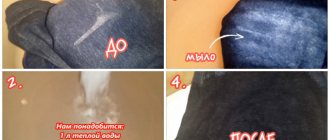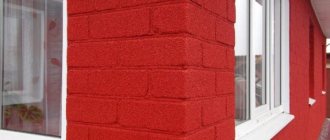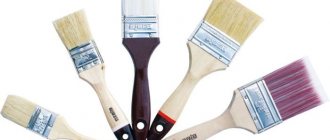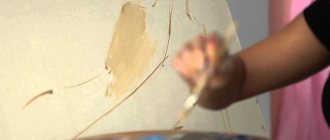How to dilute oil paint?
When choosing a solvent, pay attention to the purpose for which the paint is intended. The fact is that this type of material includes two large groups, divided by area of application:
1. Solutions used for painting surfaces of residential or commercial premises. Traditional compositions, which are presented in abundance on the shelves of hardware stores, are suitable for these purposes. Although recently the demand for these products has decreased, in certain situations an oil solution can be the optimal solution.
This mixture must be diluted in the following cases:
- The material is too thick.
- A base layer needs to be laid.
- Painting is done on wood. A composition that is not too thick fits well on such a base, otherwise it will not be possible to achieve strong adhesion.
Thinner for painting surfaces
Available materials can be used as a solvent for exterior and interior painting. Their selection is quite large.
Turpentine
This composition has steady popularity when diluting coloring products. The following types are used for working with oil solutions:
- Woody. It is made from the bark and branches of trees containing an abundance of resin. The initial solution is dark, but after processing it becomes transparent.
- Turpentine. It is obtained by distilling the resins of living coniferous trees and is an essential oil. It has many positive properties, so its scope of use is much wider than its use as a solvent.
Attention! The mixture has a specific odor, so it is recommended to carry out work in a ventilated area.
White Spirit
Turpentine can be successfully replaced with white spirit. The demand and popularity of these products is explained by their wide distribution and availability. In addition, there are varieties on sale that do not have a strong unpleasant odor.
The work process when using such a composition is very convenient. The mixture does not evaporate as quickly as other solvents, which allows you to paint without haste. Also, white spirit when added does not change the color of the composition.
Solvent
This thinner for oil paints has the number 647. Product designation may vary and depends on the components included. It is not recommended to use solvent number 646 due to the presence of acetone in it.
It is not always easy to dilute oil paint with this substance: excess leads to a deterioration in the properties of the product.
Gasoline and kerosene
These options are recommended for use in the absence of other mixtures and only for outdoor use. A significant drawback of the solutions is the specific smell, which can cause dizziness and poisoning. This is due to rapid evaporation. But kerosene is the best solution when you need to dilute an old composition that has become very thick.
Drying oil
This is a universal solution; besides, drying oil is included in oil paints. But it must be taken into account that the diluent must correspond to the type of substance that is included in the coloring material.
To obtain the necessary information, you need to pay attention to the labeling of painting mixtures. The following designations are distinguished:
- PV-024. Such products are made on the basis of pentaphthalic drying oils.
- MA-021. The composition includes natural drying oil, which contains more than 95% vegetable oils.
- GF-023. Produced with the addition of glyphthalic drying oil. It is an alternative to natural.
Correct identification of components helps to obtain the desired result.
Solvents and thinners
When working with pentaphthalic and glyphthalic materials, sometimes it becomes necessary to dilute them to the desired consistency.
For these purposes, special thinners are used. In the case of alkyd paints, thinners are also solvents, i.e. substances that can dissolve enamel coatings. In turn, the purpose of the thinner is to thin the paint and help create a uniform film. But solvent substances dissolve paints and enamels, then evaporate, thereby weakening the paintwork. Such volatile substances include white spirit, turpentine, solvent and gasoline solvent, as well as special substances that serve as solvents for certain painting materials.
The main thinner for paints based on alkyd polymers is white spirit, solvent, turpentine, xylene, gasoline solvent Nefras-S 50/170, RS-2, as well as mixtures of these reagents.
Depending on the type of material, different substances can serve as diluents, for example:
- RS-2, turpentine, as well as white spirit, solvent or a mixture of any two thinners in a 1:1 ratio serve as a thinner for PF-14, PF-1217 enamels.
- White spirit dilutes PF 1126 enamel.
- RS-2, turpentine, solvent (gasoline), white spirit, solvent, xylene or mixtures thereof act as thinners for enamels GF-230, PF-560, PF-115, PF-223.
- GF-1426 enamel is dissolved to the required consistency, using both xylene and solvent, or using a mixture of any of the above with white spirit.
When working with substances and mixtures that dissolve or dilute enamels, a number of nuances should be taken into account.
Dilution procedure
No less important is the process of diluting the paint yourself, because its accurate implementation is the key to the absence of further problems.
Activities are carried out in the following order:
- The container of paint is opened, the thickness is assessed and thorough mixing is performed. To do this, use a handy tool or a prepared clean stick.
- The required proportion is determined. For each solvent, the indicator may be different. The exact amount of the substance depends on the thickness of the paint, but should not exceed 5% of the total mass. Although, if necessary, obtain a mixture for the base layer or primer of walls, the volume of white spirit and drying oil can reach up to 10%. To dilute the mixture in the best possible way, the thinner is added directly to the jar. It should be poured in gradually in small portions. This will allow you to restore the composition and mix it well.
- Next, the paint is poured into containers for use. During the painting process, the material may thicken, so you need to periodically mix the solvent.
How to thin enamel correctly
It all depends on its purpose. The first base layer should be thin. This will help improve adhesion (stickiness). Thick, dense paint will not be able to penetrate microcracks and will peel off. PF-115 should be diluted gradually, each time checking the density of the resulting solution in a small area.
In production conditions, viscosity is determined using a viscometer - a device in the form of a container with calibrated holes. It can also be determined experimentally. A properly diluted solution spreads evenly without forming sagging. At the same time, it should paint the surface well, without gaps or streaks from the brush.
Excess solvent and reduced viscosity can lead to deterioration of enamel characteristics. It loses its shine, becomes dull, and its strength decreases.
Dilution of artistic paints
Drawing materials can also be of different thicknesses, which requires bringing them to the desired consistency. In addition, the mixture is applied to different surfaces (wooden, fabric). Therefore, oil art paints require a different approach and a list of diluting agents.
Such compositions can be diluted with the following substances:
- Oil. Purified hemp, sunflower or flax oil is suitable for the process.
- Pinen. Its other name is “Thinner No. 4”.
- Multicomponent mixtures. This can be a double and a tee: the first contains varnish and oil, and the second has pinene added to them.
It is recommended to choose the material solely from your own preferences, this will allow you to achieve the desired result. That is why such paints are diluted in proportions that are determined individually after several samples. But it is worth remembering that excess solvent can destroy the structure of the coloring material.
The process of dilution with drying oil
Thinning the paint is not difficult, but you should proceed step by step and sparingly add any diluent, because if it is oversaturated with drying oil, then it will take a longer time for the surface to dry.
Breeding stages:
- for the convenience of stirring and eliminating clots, transfer the paint and varnish substance to a suitable container;
- pour in drying oil in small portions and begin to mix thoroughly, monitoring the thickness;
- repeat the procedure of adding oil and bring the mixture to a consistency that suits us;
- wait about ten minutes, then strain the mixture through a sieve to remove any lumps.
If you add too much drying oil, the paint will take much longer to dry.
How to thin oil paint for application with different tools
Using different tools to paint walls, ceilings or other substrates involves diluting the composition to the desired viscosity level. At home, this parameter is determined using a simple device - a viscometer, which can be purchased in a store.
The device is a funnel with a nozzle, which can be of different sizes. Based on the period of time during which the poured composition flows through the hole, the viscosity level is determined in seconds.
The process looks like this:
- After adding the solvent to the paint container and mixing, the viscometer is immersed in it.
- A stopwatch is prepared in advance. You can use any other device.
- The device is removed from the composition, and the timer is turned on at the same time.
- After the mixture completely empties the glass (funnel) of the device, the stopwatch turns off. The value is fixed.
To paint the surface with brushes and a roller, the viscosity should be at the level of 10–15 seconds, and for a spray gun – 25–30 seconds, depending on the model.
The content of the article
Thin the oil paint
Probably everyone can remember a similar incident: during the renovation period, more than once, due to their own carelessness, they forgot to close a can of paint, which, to their great disappointment, caused the material to harden and was no longer suitable for use. Below are examples of possible paint solvents that will help you save thickened paint, or simply dilute new paint.
Oil paints, by themselves, can be either thickly rubbed or immediately have the consistency necessary for their application. Paints, conventionally called “thick”, are used extremely rarely in this form; most often they are diluted with a solvent. Also, already dried paints or those that are planned to be used as a primer are diluted with this specific liquid.
The type of paint solvent is determined according to the properties of the material on which the paint will be applied.
Oil paint can be easily diluted with many chemicals, which are extremely easy to purchase in hardware stores. Examples include the following solvents: turpentine (purified or not), gasoline, solvent 647 kerosene (only with the addition of a drier), white alcohol. However, white alcohol, thinner 647 and turpentine are by far the most widely used types of solvents.
What to do with dried paint
Unlike enamels, acrylic paints can be used even after drying. When the composition sits for a long time after opening the lid, it inevitably dries out. This is typical not only for enamels, but also for other materials based on synthetic substances. However, acrylic paints can be thinned. True, their properties will differ from the previous ones.
Since the composition is made on the basis of water, its addition will return the characteristic features. First you need to thoroughly crush the dried piece and place it in a container that can withstand the temperature of boiling water. Then boiling water is poured into the vessel. The procedure is repeated as the liquid cools. When all the particles have absorbed enough liquid, the process is complete.
White spirit for oil paints
The scope of the same white spirit is extremely wide. It is serious competition for turpentine, whose sales volumes fell after white alcohol appeared on the markets.
White spirit for oil paints is used in the following cases:
- To obtain an organodispersion when diluting paint and varnish coatings.
- For the purpose of diluting varnishes, primers, drying oils, enamels, car preservatives, etc.
- Used for washing brushes after finishing work.
- In order to degrease the surface if this kind of problem suddenly arises.
- Can be used as a solvent for rubber or alkyds.
This solvent is extremely popular due to its availability, because its price is quite reasonable, even taking into account the wide range of its applications.
When using white alcohol, the cost of paint or other type of paint coating is significantly reduced, but the quality of the paint remains unchanged.
If desired, it is even possible to find a type of white alcohol that does not have its characteristic pungent odor.
Rules for using white spirit for oil paints:
- We should not forget about safety precautions, so you should avoid finding solvents near any open flame sources or switches. It is also worth paying attention in advance to the fact that solvents of some compositions can spontaneously ignite under the influence of temperatures.
- You also need to pay attention to the rather pungent odor of the substance. Therefore, paint should be diluted only in well-ventilated areas or even in the open air.
- Due to the chemical composition of solvents, they should not come into contact with the skin or mucous membranes. Otherwise, you must immediately rinse the area where the substance comes into contact with water. Clothes can also be damaged by exposure to strong chemicals.
Turpentine for oil paints
Turpentine is currently a popular paint thinner. In addition, it is used in the production of rosin, as well as dammar. It can also be found in copal-based varnishes. The composition of turpentine is complex, and in itself it is like an essential oil.
Types of turpentine for oil paints:
- Stump turpentine. It is made mainly from the bark of coniferous trees, as well as stumps.
- Wood turpentine. In production, tree branches and bark, which contains resin, are used. In its original form, such turpentine is a brownish liquid, which disappears immediately after repeated processing.
- Turpentine turpentine. This type of solvent can only be compared with real essential oil, since it is obtained by distilling the resin and resinous materials of various types of coniferous trees. The valuable properties of this oil are not lost even after secondary processing, which is its undoubted advantage.
What's in it?
The composition of alkyd painting materials largely determines the properties and characteristics of varnishes, paints and primers. In general, any paint and varnish material contains ingredients such as:
- coloring pigments;
- various excipients;
- thinners;
- driers – substances that accelerate drying, etc.
As for alkyd paints, they contain alkyd polymers (resins) as foaming agents . But depending on the type of resin, pentaphthalic and glyphthalic binders are distinguished, and, accordingly, pentaphthalic (marking - PF) or glyphthalic (GF) enamels, primers and varnishes are produced. In addition, on alkyd drying oil, in addition to traditional liquid ones, thickly grated compositions are also produced (GF-013, PF-014, etc.). Enamel painting material, or simply enamel, is a paint with which you can obtain not a matte, but a glossy or even mirror-like surface.
The segment of alkyd materials includes paints having the following base:
- drying oil (marking – MA);
- glyphthalic and pentaphthalic varnishes (marking – GF and PF);
- oil-phenolic varnish (marking – FA).
Solvent 647 for oil paints
Solvent 647 is a fairly strong, colorless chemical that is highly flammable and also emits a strong, unpleasant odor, which is quite typical for this type of solvent. This liquid is often used to dilute alkyd enamels and pentaflathein enamels. They are often used to dilute varnishes or putty. The surfaces to be painted are first degreased with a solvent. Various industrial tools and parts are also washed with this liquid, and in addition, solvent 647 is used to clean contaminated fabric.
When diluting paint, you should be extremely careful in its ratio of solvent, since if the amount of solvent is incorrect, the paint can easily be damaged. In diluted form, the paint is used for better penetration into the surface material. A mixture of paint and solvent is also used as a primer.
Mix it well for 10-20 minutes until smooth.
Diluting paint requires a specialist to follow technologies according to which the paint will ultimately obtain the required consistency.
Before painting, it is important to understand the fact that simply diluting the paint will not be enough; it is important to do it correctly and bring the solution to the desired viscosity.
The required working viscosity is a qualitative indicator of any protective coating, no matter whether it is varnish, paint or liquid putty.
It is quite obvious that the surface to be coated has some micro-irregularities that remain after preparation. If a liquid filler is used to process such a surface, then it may not eliminate these irregularities, since a thin film of filler does not have the ability to fill these microirregularities, and often it is still necessary to calculate the margin for grinding. To correct this shortcoming, this surface is over-primed, but this entails extra costs for consumables and time for work.
If you overdo it with the density of the filler and apply it too thick, then having a very high density, the filler simply will not be able to penetrate with its structure into micro-irregularities, as a result of which peeling of the soil and negative adhesion may occur. In addition, a filler with too high a density does not have the ability to spread in an even layer on the surface, which causes increased shagreen, which can only be removed by careful sanding, which again entails unnecessary work costs.
All these manipulations, in fact, are just preparation for painting; painting and varnishing itself is much more complicated and entails greater labor intensity, such as coating strength or shade, and these indicators depend specifically on viscosity.
Some experts are trying to make the filler more liquid, thinking that a more liquid substance can fill all sorts of surface irregularities, and applying such a substance will greatly increase its thickness. However, such tests are false. Repeatedly applied material contains a large percentage of solvent, and this can lead to the surface drying more slowly, hardening poorly and ultimately losing adhesion, which increases the possibility of shrinkage and chipping.
How can this be avoided? The correct solution would be to measure and adjust the paint to the desired viscosity, i.e. thin the paint.
How to measure paint viscosity
The main instrument for measuring viscous paint and paints and varnishes is a viscometer. It is a small measuring container, the holes of which are clearly calibrated. Viscosity will be the time in seconds measured for the paint to flow out of the device opening. The longer the time, the more viscous the paint turns out, and vice versa - if the time is short, then the viscosity will ultimately be low. Viscometers are differentiated depending on the viscosity of the material. Such devices have differences in the volume and diameter of the hole.
How to Determine Paint Viscosity Using a Viscometer
To determine the viscosity of paint, varnish or primer, take a viscometer and fill it completely to the brim with the selected material, while closing the hole with your finger, measure the time using a stopwatch, and at the same time open the hole in the viscometer, which was previously kept closed. We follow the stream flowing through the hole. As soon as the stream stops flowing as a single stream and turns into droplets, the stopwatch must be turned off. The time in seconds that is recorded on the dial will be the measured viscosity, indicated in DIN seconds.
For finished paints, the viscosity is indicated on the can or in the technical specifications for the paint and varnish material. However, you should not always trust what is written, sometimes it is worth double-checking this data and after checking, if the data indicated on the can and the calculations carried out using a viscometer differ, for example, the viscosity turned out to be higher than recommended, then such paint will need to be diluted. Sometimes the viscosity of paint is determined “by eye”, however, relatively accurate data in such a determination can only be achieved with extensive experience in painting work.
When diluting paint, measuring rulers and containers are used to maintain proportions. The measuring container is part of the toolkit used to dilute the paint and is a transparent plastic jar on which the proportions are marked using notches. Paint dilution can be done using a regular plastic glass, however, before work it must be checked for resistance to solvent - pour a small part of the specified liquid into it and after a while see if the solvent has leaked out. If everything is in order, no holes have formed in the glass from the chemical substance, then you can safely use this glass for diluting paint.
After thinning the paint, be sure to get rid of insoluble elements and debris. To do this, strain it through a sieve or use gauze folded in several layers as a filter.
Types of paints
1). Water-dispersion paints
Water-based paints and varnishes consist of pigment, water and a material that binds them. This type of paint includes watercolor, gouache and acrylic, which is the most popular and in demand due to its waterproof properties. Acrylic paints are used both indoors and outdoors, dry quite quickly and are considered environmentally friendly. This purity factor is due to the fact that clean, cold water is used to dilute water-based acrylic paints.
2). Oil paints
They are perfect for outdoor use due to the fact that they create a protective layer that does not allow moisture and water to pass through. Oil paints are made from all kinds of essential oils and dyes. That is why, when diluting oil paints, white spirit, drying oil and oil-resin varnish are used.
Enamels are represented by the largest variety on the paint market. This is due to the fact that they can be diluted with almost all solvents: turpentine, white spirit, gasoline, solvent, xylene, solvents R-4, R-6, No. 646 and No. 645.











